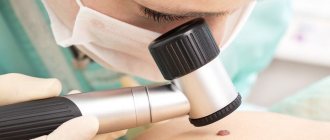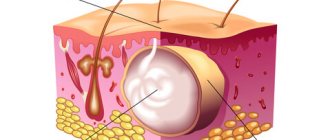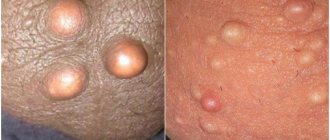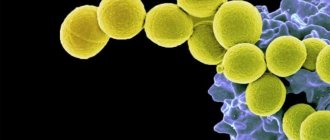Scientifically, “bumps” from injections are called post-injection infiltrates of the buttocks. “They are lumps that appear some time after an intramuscular injection,” says the head of the outpatient surgery department at one of the medical clinics in Moscow. “They are a pathological response of the body to the administration of a drug, regardless of its type.”
There are several types of “bumps” on the buttocks after an injection. “The first option is an infiltrate, that is, a local reaction, which is characterized by a tissue response at the injection site - edema,” explains the surgeon, graduate student of the Faculty of Internal Medicine, Department of Surgery, Department of Surgical Endocrinology, State Budgetary Healthcare Institution MONIKI named after. M. F. Vladimirsky. — The second option is a hematoma. It appears from hemorrhage of a damaged vessel after injection; unfortunately, it is impossible to predict this in advance.”
The third option (and the most dangerous) is an abscess. “Abscesses are very painful formations with purulent contents and a vivid clinical picture; they can only be treated surgically,” adds the doctor.
In fact, “bumps” are a local reaction of the body to a puncture and intramuscular injection of the drug. If left untreated, the infiltrates can become abscesses, which pose a serious health threat. “In most cases, in relatively healthy people they go away within a week, but there are exceptions,” the doctor notes.
Why do bumps appear from injections on the buttocks?
Several factors can lead to the formation of swelling after injections.
- Injection technique.
Have you heard that after injections, nurses with a “light” hand do not get “bumps”? There is a deal of truth in it. “Incorrect intramuscular injection site, administering the drug too quickly, or getting the needle into a nerve or vessel can cause injection bumps,” says the specialist. “Also, compactions can appear as a reaction to the simultaneous administration of a large volume of the drug, frequent injections into the same place,” adds Bulat Yunusov, surgeon at GMS Clinic. - Allergic reaction.
“It can develop due to an overreaction of the immune response to the drug,” the doctor adds. Or - a mixture of drugs. - “Many patients, when injecting themselves, commit the sin of mixing several different drugs in one syringe, which is strictly prohibited. This can cause irreversible complications and serious allergic reactions,” says the doctor.
- Consistency of the drug.
“Oil solutions most often cause swelling and swelling,” says Bulat Yunusov. — These are the drugs that can only be administered intramuscularly. Such injections are characterized by a longer resorption time, and, consequently, an increased risk of complications.” - Incorrectly selected needle.
“A needle that is too long or too short leads to the fact that the medicine enters either very deep muscle layers or into the subcutaneous fatty tissue, that is, it does not reach the muscle layer,” the doctor notes. - Excessive muscle tension during injection.
Intramuscular injections must be performed with a relaxed muscle and preferably in a prone position. - Patient's body weight.
“Build and weight are also factors that need to be taken into account when administering injections,” adds Bulat Yunusov. — Obese patients have a lot of subcutaneous fat. If a drug gets into it, it will inevitably lead to the formation of inflammatory changes (infiltrates, abscesses).”
To prevent injection bumps from appearing, experts advise doing injections following certain rules. “It is important to use needles of the appropriate length and diameter; the choice depends on the patient’s age, injection site, volume of fluid, amount of muscle and fat tissue and solution viscosity,” says Bulat Yunusov. — It is necessary to strictly observe the rules of asepsis and antiseptics. It is preferable to perform injections while lying on a couch or bed.”
How to prepare for the injection?
If you are to undergo a course of therapy with intramuscular administration of drugs, then purchase three-component syringes (they have a black gasket on the piston). Such syringes inject the medicine evenly, in a thin stream, which prevents damage to blood vessels and does not cause bruising. Three-component syringes are best purchased from a trusted pharmacy. Before the injection itself, relax as much as possible, it is best to lie on your back.
A short massage of the injection site with an alcohol cotton swab (tampon) or light slaps on the site of the future injection helps.
If drugs are to be administered in particularly sensitive areas, for example, anesthesia when removing fibroids on the face, then a week before it is necessary to abandon aggressive peelings and other care procedures.
How to treat bumps on the buttocks
Regardless of the reason for which you have painful lumps after injections, they still need to be treated. “You definitely shouldn’t self-medicate, especially with “fresh” infiltrates, since any infiltrate can both resolve and fester. I’ll immediately explain what a “fresh” infiltrate is. This is a lump that you discovered immediately after the injection or is not older than 14 days. If the infiltrate is 1-2 months or more old, then the probability of its suppuration is quite small, but the probability of its complete resorption also tends to zero,” notes the specialist.
If it doesn’t reach the point of an abscess, then you can get by with fairly simple means - using gels, ointments and compresses. “What specific medication you need, the frequency and duration of its use, is determined by the doctor during an in-person visit after examination and carrying out the necessary examination methods (ultrasound of soft tissues),” says the doctor.
At home, hematomas and infiltrates can be treated with safe means. “Moderate massaging of the injection site, performing squats and applying cold compresses to the site of swelling in the first 1-2 days after its appearance is acceptable,” reminds Bulat Yunusov.
“Bumps after injections can be treated with an iodine mesh, but it is better to see a surgeon so that he can prescribe physical therapy,” the general practitioner recommends.
Physiotherapy is prescribed as an addition to the main treatment, which allows it to be shortened. Among the most effective methods are:
- Electrophoresis
is the penetration of medicinal drugs into the skin and soft tissues under the influence of an electric field. - UHF.
“This is the treatment of infiltration with a continuous or pulsed ultra-high-frequency electric field,” comments a doctor at a Moscow clinic. - Phototherapy.
Irradiation of problem areas with ultraviolet light in a narrow or wide range.
What to do after the procedure?
To prevent hematomas after intramuscular injections, try applying an iodine mesh to the injection site. Renew your iodine pattern at least 3 times a day. Betadine is well suited for young children with delicate and sensitive skin.
If a bruise does appear, then you need to apply a vodka or alcohol compress to it (for 30-40 minutes). The hematoma will completely disappear 2-3 days after the first application of the compress. There are various ointments and gels that can prevent or eliminate hematomas that have already appeared after intramuscular injections - these are almost any ointments created on the basis of bodyaga, troxerutin and heparin.
If you experience persistent pain, redness and persistent swelling at the injection site, immediately consult a doctor, as the development of an abscess can lead to sepsis. In this case, the clock literally counts, and there is a real risk of death.
Lumps after injections on the buttocks: when to sound the alarm
If the injection is done correctly and you are not allergic to the drug, most likely there will be no swelling in the buttocks. “A person may experience slight discomfort after the injection, which goes away within a few minutes - after intense walking or squats,” warns Bulat Yunusov.
However, if you experience any of the following symptoms after the injections, you should contact your doctor:
- persistent severe pain at the injection site;
- prolonged tingling or numbness;
- prolonged bleeding from the injection site;
- signs of an allergic reaction, such as difficulty breathing or swelling of the face;
- skin redness, swelling, local hyperthermia, pain, fever and other symptoms of a systemic inflammatory response;
- if the compaction does not go away for more than 2 months.
Do not delay visiting your doctor as this may have serious health consequences.
Diaskintest: what is it (Sergiev Posad)
Diaskintest - what is it?
Sometimes people wonder what kind of vaccine Diaskintest is.
But this is not a vaccination, but a test sample. The Diaskin test shows the body's response to tuberculosis in inactive or active forms. A positive result on this test is an absolute indication for starting chemotherapy to prevent the disease from becoming active. Diaskin test
is an immunological test in which protein allergens (antigens) are introduced into the skin to detect the body’s immune (interferon) response. If the answer is yes, then the human immune system is familiar with these protein allergens. This indicates that the person is either infected or is in an active stage of the disease.
How is Diaskintest done?
The test for tuberculosis is carried out in the traditional way like all other tests.
Diaskintest is done on any hand in the forearm area (the space between the wrist and elbow). If a person is right-handed, they try to place the test on the left hand (and vice versa, for a left-handed person - on the right), as it is less active, in order to minimize possible external mechanical irritation. But there are cases when the Mantoux and Diaskin tests are performed simultaneously on different hands. In general, the main thing is that the person does not scratch the injection site and does not accidentally provoke an irritating reaction.
The test for tuberculosis is administered intradermally with a special tuberculin syringe with a thin needle.
Why is Diaskintest vaccinated?
Since many are still confident that the Diaskin test is a vaccination, and today there is an increasing irrational negative attitude towards vaccinations, for example, parents often wonder whether or not to do the Diaskin test for their children. There cannot be any alternative here, and discussions about the pros and cons are beyond common sense.
Tuberculosis is an infection that develops covertly and asymptomatically for a long time. If you have had even a single contact with someone with a latent form of this disease, you may also get sick.
Tuberculosis, manifested by typical symptoms - fever, cough, weight loss, etc., is a difficult disease to treat. If you start treating it in the latent phase, then the cure is always one hundred percent. It is impossible to detect the disease at this stage without performing allergen tests.
How often can I do it?
Diaskintest is done as often as required by the recommendations of the Ministry of Health: the test is mandatory for all children from 8 to 17 years old once a year.
When deciding how often a diaskintest can be done for a child or an adult, they are guided by the following standards:
After a negative test, the next one can be done after 2 months; after any vaccination - in a month; after suffering acute infectious diseases - in a month.
For those who are registered with a phthisiatrician at an anti-tuberculosis dispensary, a control test is performed once every 3–6 months.
Diaskintest can be done from the age of 1 year upon receiving a positive Mantoux test.
Preparation
No preparation is required for the Diaskintest analysis. A necessary condition is the absence of any infectious diseases for a month before and at the time of the test.
Evaluation of results
Diaskintest is checked on the 3rd day after placement.
How to evaluate the result:
- Negative (normal);
- Doubtful (false positive);
- Positive.
Normal for children and adults
The norm according to Diaskintest is complete absence of reaction: no redness, no swelling (papules).
Reaction by day
The reaction to Diaskintest by day is not significant. Redness may occur on both the first and second days. This is not a very good sign, but a false positive reaction is quite likely.
The first reaction may appear 6 hours after the injection.
The result of diaskintest is the body’s immune response. The intensity of this response is influenced by the general immune status. For a person who is not in an immunosuppressed state, the response to an introduced allergen in the presence of a latent form of tuberculosis will be dynamic. Redness and the appearance of an inflammatory reaction in the form of a papule are possible already on the first day after the Diaskin test. Over the course of 72 hours, the reaction will increase, showing maximum results in both children and adults after 3 days. Further, the reaction will begin to fade, after which it will not be possible to make a correct assessment.
Negative result
Of the visible signs, the following are considered normal (i.e. the Diaskin test is negative):
- injection mark;
- possible 1-2 mm bruise at the injection site;
- a colorless compaction with a diameter of no more than 1 cm at the site of the sample (“button”, “lemon peel”).
Thus, the Diaskin test should not show redness or papule.
False positive result
The test may be false positive or questionable. This is how the presence of redness without the formation of a papule is classified.
In case of a false-positive Diaskintest, the person should be referred for further consultation to an anti-tuberculosis dispensary, where he undergoes additional tests, fluorography, and also undergoes a repeat Diaskin test after 2 months.
Positive result
If a person has a positive diaskintest result - that is, an inflammatory papule of any size is present - this means that such a person is infected with the tuberculosis bacillus.
In an adult
With a positive diaskintest in an adult, the size of the papule does not matter; the fact of its presence is important. For classification purposes, the conventional sizes of swelling at the injection site were established:
- up to 5 mm. - weak;
- up to 9 mm. - moderate;
- more than 10 mm. - expressed.
The more pathogens there are in the body, the larger the inflammatory process at the injection site.
What to do if the diaskintest is positive: treatment and registration at a dispensary is necessary.
The child has
A logical question for any parent: what to do next if the diaskintest shows a positive result. Additional tests will be required to determine whether the disease is latent or active.
Complications and side effects
Diaskintest does not cause any harm or complications. The bacterial fragments it contains are not harmful to either a child or an adult.
Very rarely, the side effect of Diaskintest can manifest itself in the form of symptoms of general intoxication:
- temperature increase;
- malaise;
- headache;
This is a normal immune reaction to the administration of a protein drug.
Hyperergic reaction
A hyperergic reaction to Diaskintest is a positive result with the formation of a large papule more than 15 mm, irritation and inflammation of the tissue around it.
Bruise at the injection site
A slight bruise after diaskintest is not dangerous and is considered a normal side effect of the procedure.
Contraindications
Diaskintest has contraindications:
- any acute disease or in the acute phase;
- skin diseases;
- epilepsy;
- allergic conditions;
- vaccination (including BCG vaccination) within 1 month. before testing.
Can this be done if you have a cold?
Colds, ARVI, cough and runny nose are acute infectious diseases. The Diaskin test cannot be performed with these symptoms.
Allergy to Diaskintest
The drug contains a foreign protein. Therefore, it itself is an allergen. Diaskintest can cause allergies and allergic reactions. Allergic conditions are a contraindication for testing.
Contraindications for children
In addition to the above, there are no other contraindications, including for children.
What can and cannot be done?
What not to do after vaccination with Diaskintest:
- apply detergents, cosmetics and perfumes to the sample site;
- apply any medications to the injection site;
- rub and scratch the injection site;
- cover the sample with a plaster or wrap it with a bandage.
Otherwise, you may get redness on the first day and have an incorrect assessment of the results.
Is it possible to wet your hand?
It is not prohibited to wet your hand after the diaskintest.
Is it possible to wash after Diaskintest?
Can. But you should avoid getting detergents on the sample site.
Is it possible to eat sweets?
There are no restrictions that the Diaskin test imposes in this regard.
What should you not eat during diaskintest?
There are no dietary restrictions. You can eat the foods you normally eat.
Conclusion
Diaskintest can make mistakes, like any medical test technique. The sensitivity of this method is about 80%. Accuracy - almost 100%. The Diaskintest tuberculin test is an order of magnitude more accurate than the outdated Mantoux test. Mainly due to the fact that it does not show a positive reaction in individuals with acquired anti-tuberculosis immunity.
Therefore, Diaskintest tuberculin diagnostics is the most reliable and safe way to find out whether a person has tuberculosis.
The cost of the procedure is 1000 rubles. Pediatrician appointment 950 rub.











